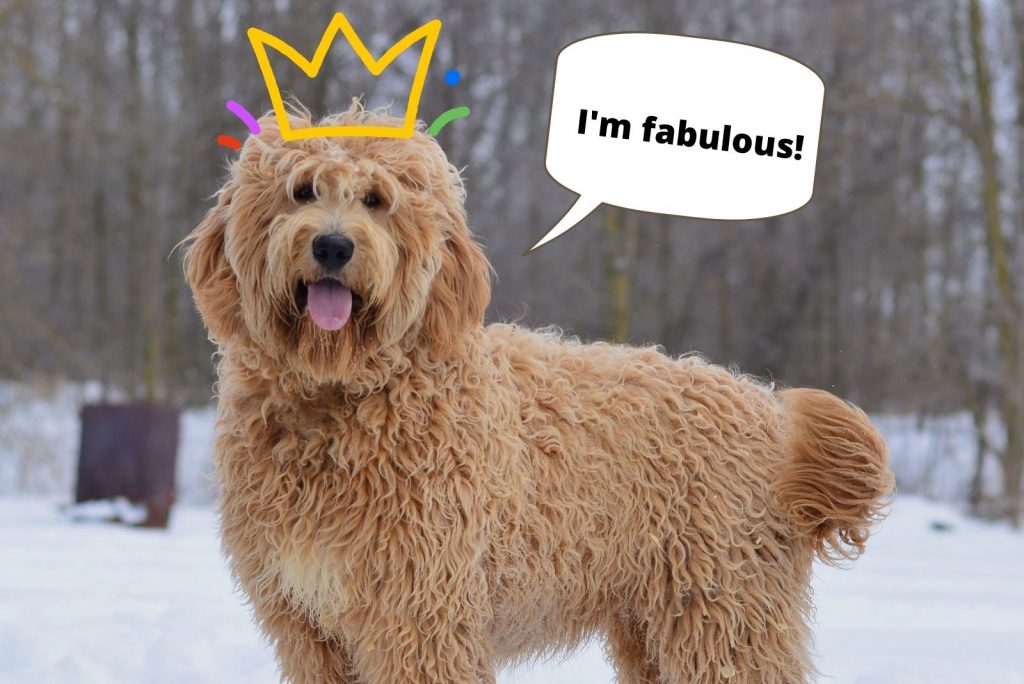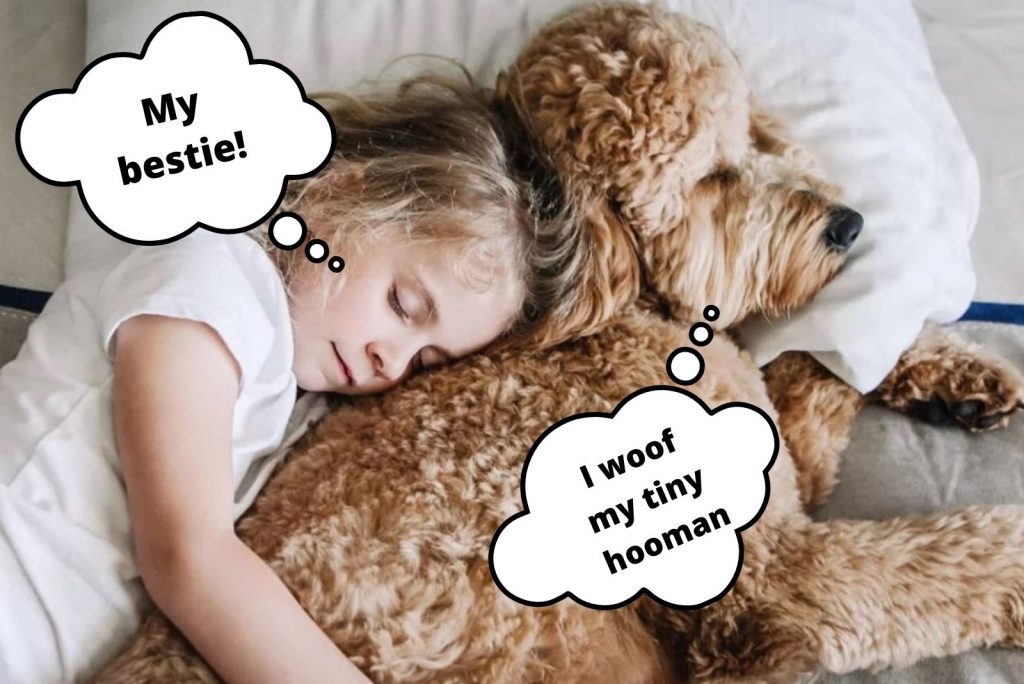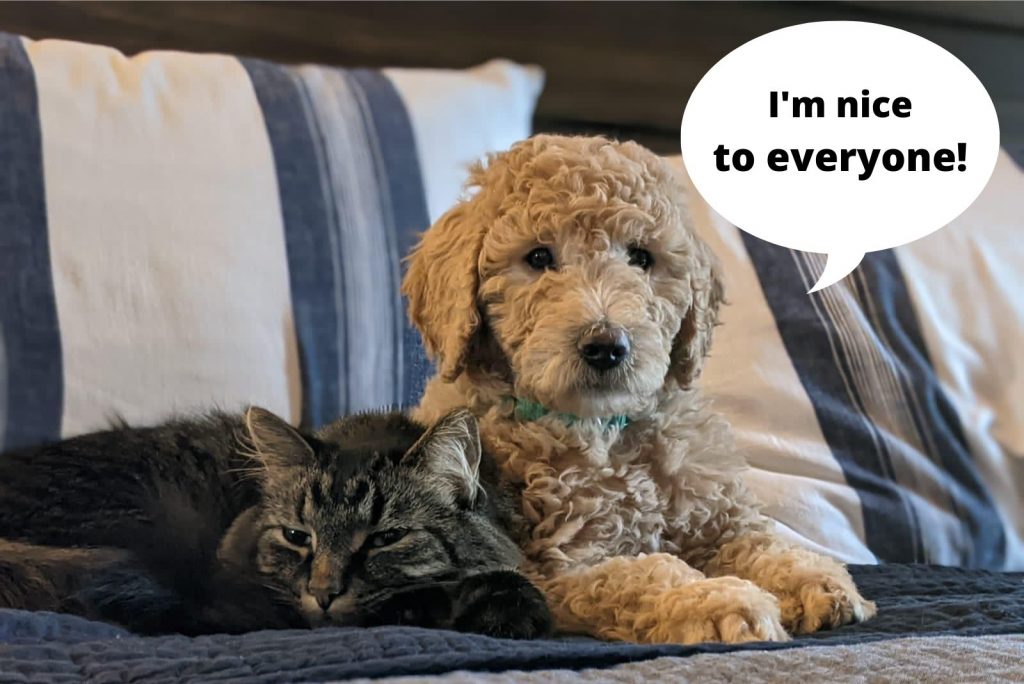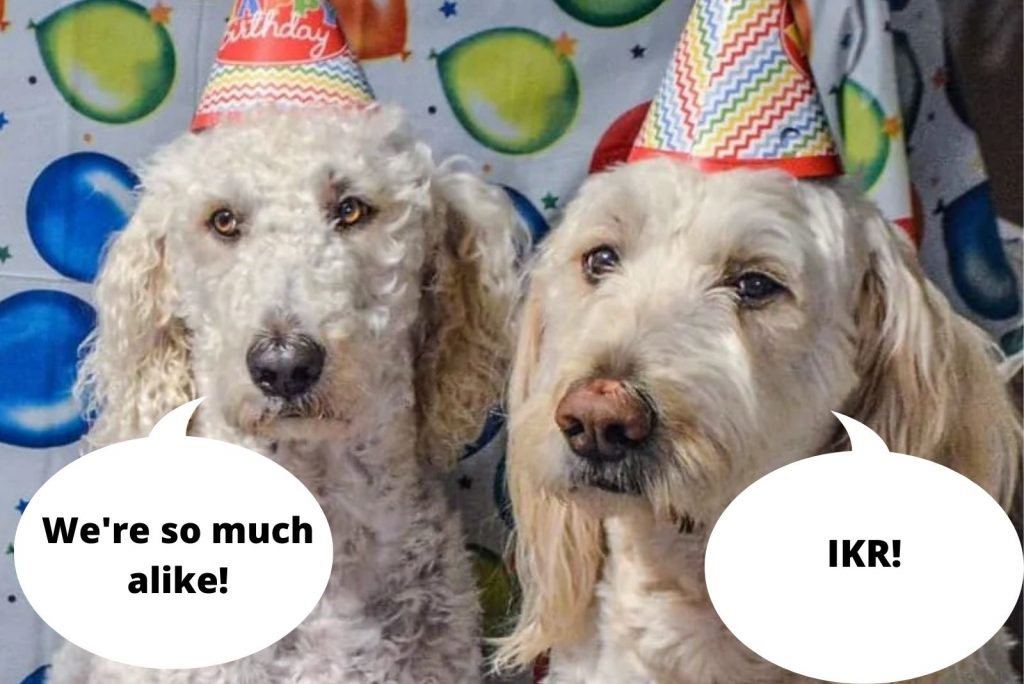Admit it: you probably had no idea what an English Goldendoodle is!
Is it a posh, royal kind of Goldendoodles?
Not really, but don’t worry at all. We’ve got you covered. We chose ten things about this amazing crossbreed that will leave you wanting to have a dozen of these puppies at least.
Although there’s so much more to find out about this cute mixture of two incredible purebred dogs, these are the ones you should know first.
Let’s see together what’s so special about these golden puppies and is the English version better than its American cousin.
1. How the Golden Retriever and the Poodle Fell In Love

Oh, the 1990s! Such a turbulent decade! Many of the famous couples warmed up our hearts and later shattered them into pieces when they broke up.
Many, but not the Golden Retriever and the Poodle. These two love birds fell for each other and their love was crowned with a puppy: the Goldendoodle!
The Goldendoodle is considered to be one of the latest additions to the Doodle family, right after the Cockapoo and the Labradoodle.
The whole point of creating another Doodle was to get a puppy larger than the others, but still having low-dander and non-shedding to low-shedding coat features, and possessing the loving nature of the English Golden Retriever.
Most of the Goldendoodle pooches are still young, which means they’re the result of first-generation breeding.
This means that the mom and dad are still Toy Poodle and Golden Retrievers. Rarely any Goldendoodle is a result of love between two Goldendoodles.
2. A Family’s Favorite Teddy Bear Puppy

Goldendoodles are considered one of the ultimate family pets.They’re loving and obedient fellows who love their family and devote themselves completely to it.
Because of their teddy-bear look, Goldendoodles are extremely popular. No wonder they’re true social dogs!
Your Goldendoodle will be the happiest around you, the rest of the family, and your other pets. The more, the merrier! The terms family companion and family dog fit these dogs the best.
However, if you leave them alone for a certain period of time, they’ll turn their back to obedience and become frisky little rascals.
Getting them over to the obedient side isn’t complicated at all, even for rookies! They’re such smart creatures that are easy-going and very eager to please. You’ll see that you’ll have a well-behaved puppy in no time. Yes, puppy, not a grown dog!
3. Hybrid Vigor: A Unique Trait You’ll Love

Unfortunately, Goldendoodles aren’t purebred pups… they’re a crossbreed, or better yet, a designer dog that shows signs of being a hybrid vigor. But, what is a hybrid vigor? For those dog lovers who haven’t had a chance to hear this before, a hybrid vigor is:
a cross between two unrelated dog breeds, which are purebred, that happens to be healthier and better than any parent line.
“Conversely, random mating and outcrossing in mixed breed dogs may result in the health-increasing effects of hybrid vigor or heterosis through a reduced likelihood of both parents of a dog being carriers of the same recessive disorder.” says a study. |1|
Now that you know what a hybrid vigor is, you’ll notice how the cross between the Poodle and the Goldie is one tremendous puppy!
4. The Generation G: Breeding the Goldendoodle

As we mentioned before, the Goldendoodle is a fairly young dog breed, meaning most of the dogs are still direct offspring of the original parent breeds.
The English F1 Goldendoodle is a mix between an English Golden Retriever and a Poodle. This combination is divided equally: 50% Goldie and 50% Poodle.
The first-generation Goldendoodles seem to be light shedders. Some pups don’t shed at all while others have a moderate level of shedding. This is terrific news for families with allergies who are seeking a dog.
The English and the Australian F1B Goldendoodles are a cross between several bloodlines: the English F1 Goldendoodle and the Poodle or Australian Labradoodle.
The statistic has two variations:
- 75% Poodle to 25% English Golden Retriever
- 25% English Golden, 25% Poodle to 50% Australian Labradoodle
The Australian F1B Goldendoodles are also called the Double Doodle. They’re dogs blessed with silky soft, completely non-shedding coats.
The F2B Goldendoodle is a result of crossing a F1 Goldendoodle and F1B Goldendoodle or F1B Goldendoodle. Also, if you cross an F2 Goldendoodle back to a Poodle, you’ll get a F2B Goldendoodle.
The F1B backcross usually happens when the Goldendoodle breeders cross an F1 Goldendoodle with a Poodle or an Australian Labradoodle.
The F3 Goldendoodle is a result of crossing the F1b or F2 Goldendoodle with another F1b or F2 Goldendoodle.
The multi-generation Doodles are a combination of an F1B crossed with another F1B or a multi-generational Goldendoodle. Their coats can range from wavy to curly, depending on the parents. What’s certain is that their coat will be completely shed-free!
5. Coat Type: The Most Beautiful Goldendoodle Trait

Truly, it’s the coat that makes these pups so special at first glance.
Depending on the generation, Goldendoodles can have various shedding levels. The F1 Goldendoodle coat usually sheds a small to moderate amount of fur. There can be some hair flying around at some point, but it is more likely there will not be any.
So, there’s no point in shaving this pup, as many people think there is.
Yes, those dark jeans you own will be thanking you for getting this Doodle!
The Goldendoodles are the finest allergy-friendly pups. The American Kennel Club or AKC recommends many other dog breeds for allergy-prone people, but their list has a lot to do with the fact that the Goldendoodle isn’t AKC recognized.
The F1B Goldendoodle sheds even less than the F1, but the level of shedding can vary from non-shedding to light. Test the parent dogs’ coats for the right genetics and you’ll be sure to get a non-shedding puppy.
The F1B has a curlier coat, but it can still appear wavy and loose, depending on whether it takes after the father or the mother.
The coat length can go from three to six inches when left uncut. The color variations are numerous and absolutely stunning:
- gold
- apricot
- red
- cream
- chocolate
- silver
- black
- parti
- phantom
To keep their fluff very fabulous and soft, a regular brushing routine and semi-regular grooming sessions are a must.
6. English Goldendoodle Size: Not Bigger Than Their Heart

If the English Goldendoodle was as big as its heart, then we would have a ginormous dog.
Good thing we got them so sweet, mini, and adorable!
The standard rule for detecting the crossbreed’s size is to add their parent’s weights together and divide it by two. This way, you’ll get the average adult weight of your pup.
Some examinations have proved that puppies that come from smaller dads tend to be smaller themselves. There isn’t a general rule. Many dogs go over and under the average size line. Some are even so small, they’re categorized as petite, micro and teacup, but that’s a whole different story.
But, still, there’s a general classification of three sizes:
- small or mini (20 to 30 lbs)
- Miniature or medium (30 to 50 lbs)
- standard (50 to 80 lbs)
READ MORE: How To Tell How Big A Mixed Puppy Will Get
7. Personality: The Sweetest Doodle of Them All

No wonder why the English Goldendoodle became such a popular mutt. The list of his positive traits is endless.
These are the pups that are not afraid to show affection. They’re gentle and patient family companions that are especially good for people with small children.
Generally, the Goldendoodle has a nice temperament, both male vs female. Of course, when the mood strikes, they can get a bit naughty, but all for the sake of fun. With proper training, obedience and potty too, they can be straight A students and exemplary pups!
Numerous factors affect their temperament, including inherited traits, training, and socialization.
Every dog needs to be socialized. Early socialization should be a must for every dog, not just our Goldendoodle pup. It’s the only way to ensure that the puppy will grow into a dog that accepts people, animals, and situations that act differently on them.
“…puppies without exposure to humans before the age of 14 weeks are unable to form normal relationships with humans.” |2|
When you have a dog that’s so easygoing, it would be a shame not to teach them obedience for the sake of a better life together. Since we’re talking about their life, it won’t be half bad to mention that Goldendoodles have an incredibly long lifespan of 15 years!
8. Taking Care: From Goldendoodle Puppies to Old Fellas

Since we have already mentioned how important obedience training and early socialization is, let’s add another thing to that list. It’s called exercising.
The Goldendoodle has an average energy level, meaning he needs around thirty minutes of family exercise. This doesn’t mean you should let your dog run around like he’s got the zoomies.
Go play together! Take a walk, throw a ball, go swimming, wrestle around…
Or simply: have fun!
When getting a Goldendoodle, always check out the parent’s size to see how big your puppy will get. The Goldendoodle can grow up to be a large dog that needs space.
So, if you’re planning on squeezing one into your small apartment, better move to a place with a nice big yard or choose another Goldendoodle size.
9. Goldendoodles Taking Care Of YOU

It’s natural for you to take care of your Goldendoodle, but what about your Goldendoodle taking care of you?
These Doodles are famous for being excellent therapy dogs for people with disabilities, especially for children. Their loving personality fits great with anyone, and they are perfect for any job that requires human contact.
Many English Goldendoodle dogs work as service dogs or therapy assistants. Isn’t it wonderful to have a dog with a purpose?
10. English Goldendoodle and American Goldendoodle: Brothers or Not?

An English Goldendoodle is a puppy bred by using the English Golden Retriever. An American Goldendoodle is a puppy bred by using the American Golden Retriever. The only difference in breeding between these two pups is the origin of their parents.
Still, there are many general differences between these dogs. Most of them are based on different health, temperament, and physical differences.
Since our topic of the day is the English Goldendoodle, a slight advantage goes in that direction, and also because they seem to be healthier than their American cousins.
There it is!
Now, you’re richer for ten new things you just learned about the English Goldendoodle.
Honest word: we were also surprised to see how wonderful the Goldendoodles are. They’re definitely little teddy-bear-looking angels of the dog world.
Now that you know so many Goldendoodle facts, how many puppies are you getting? One, two, ten? What’s your golden number?
Sources:
|1| Jonas Donner , Heidi Anderson, Stephen Davison, Angela M. Hughes, Julia Bouirmane, Johan Lindqvist, Katherine M. Lytle, Balasubramanian Ganesan, Claudia Ottka, Päivi Ruotanen, Maria Kaukonen, Oliver P. Forman, Neale Fretwell, Cynthia A. Cole, Hannes Lohi. (2018). Frequency and distribution of 152 genetic disease variants in over 100,000 mixed breed and purebred dogs. DOI
|2| Tiffani J Howell, Tammie King, Pauleen C Bennet. (2022). Puppy parties and beyond: the role of early age socialization practices on adult dog behavior. DOI















